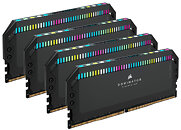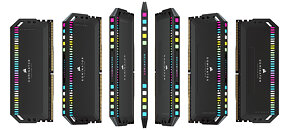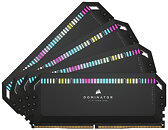- Joined
- Oct 9, 2007
- Messages
- 47,233 (7.55/day)
- Location
- Hyderabad, India
| System Name | RBMK-1000 |
|---|---|
| Processor | AMD Ryzen 7 5700G |
| Motherboard | ASUS ROG Strix B450-E Gaming |
| Cooling | DeepCool Gammax L240 V2 |
| Memory | 2x 8GB G.Skill Sniper X |
| Video Card(s) | Palit GeForce RTX 2080 SUPER GameRock |
| Storage | Western Digital Black NVMe 512GB |
| Display(s) | BenQ 1440p 60 Hz 27-inch |
| Case | Corsair Carbide 100R |
| Audio Device(s) | ASUS SupremeFX S1220A |
| Power Supply | Cooler Master MWE Gold 650W |
| Mouse | ASUS ROG Strix Impact |
| Keyboard | Gamdias Hermes E2 |
| Software | Windows 11 Pro |
CORSAIR, a world leader in enthusiast components for gamers, creators, and PC builders, today announced new kits of its acclaimed DOMINATOR PLATINUM RGB DDR5 high-performance memory reaching frequencies up to a blistering 6,400 MHz. Available in kits of 2x16GB, DOMINATOR PLATINUM RGB 6,200 MHz and 6,400 MHz hit a new milestone with these unprecedented speeds, and are now more customizable than ever thanks to the new XMP Manager in CORSAIR iCUE software.
CORSAIR led the charge in next-generation memory with the release of DOMINATOR PLATINUM RGB DDR5 and VENGEANCE DDR5 for the Intel Z690 platform earlier this year, delivering higher frequencies in greater capacities than previously possible. Now the ceiling for DDR5 performance has risen again, with DOMINATOR PLATINUM RGB once more pushing the boundaries for the most powerful systems leveraging 12th Generation Intel Core Processors.




A version of CORSAIR iCUE software with XMP Manager is now available for download, offering an unparalleled level of control and customization to enthusiasts with the latest CORSAIR DDR5 memory. XMP Manager enables onboard voltage regulation of DDR5 memory through iCUE, delivering more precise, stable overclocking with custom Intel XMP 3.0 profiles that can be saved directly to the module, to easily tailor performance to specific tasks.
DOMINATOR PLATINUM RGB DDR5 is designed with a bold, refined aesthetic to complement its world-class performance, illuminated by 12 ultra-bright individually addressable CAPELLIX LEDs per module and expertly constructed with beautiful forged aluminium. Its patented DHX cooling design ensures that performance is not held back even at frequencies of 6,400 MHz. As with all CORSAIR memory, DOMINATOR PLATINUM RGB is backed by a limited lifetime warranty.
With the DDR5 generation, overclocking enthusiasts are smashing previous speed limits with the help of CORSAIR modules. In November, overclocker David Miller, aka mllrkllr88, set a new record level of speed for CORSAIR DDR5 memory by reaching a speed of 8,149 MT/s when cooled with liquid nitrogen.* These verified results establish CORSAIR as a top choice for overclockers looking to achieve the world's fastest frequencies. As speeds continue to increase in the DDR5 generation, CORSAIR remains on the cutting-edge of performance.
For PC enthusiasts looking to equip their newest masterpieces with nothing but the best, DOMINATOR PLATINUM RGB remains in a class of its own.
View at TechPowerUp Main Site
CORSAIR led the charge in next-generation memory with the release of DOMINATOR PLATINUM RGB DDR5 and VENGEANCE DDR5 for the Intel Z690 platform earlier this year, delivering higher frequencies in greater capacities than previously possible. Now the ceiling for DDR5 performance has risen again, with DOMINATOR PLATINUM RGB once more pushing the boundaries for the most powerful systems leveraging 12th Generation Intel Core Processors.




A version of CORSAIR iCUE software with XMP Manager is now available for download, offering an unparalleled level of control and customization to enthusiasts with the latest CORSAIR DDR5 memory. XMP Manager enables onboard voltage regulation of DDR5 memory through iCUE, delivering more precise, stable overclocking with custom Intel XMP 3.0 profiles that can be saved directly to the module, to easily tailor performance to specific tasks.
DOMINATOR PLATINUM RGB DDR5 is designed with a bold, refined aesthetic to complement its world-class performance, illuminated by 12 ultra-bright individually addressable CAPELLIX LEDs per module and expertly constructed with beautiful forged aluminium. Its patented DHX cooling design ensures that performance is not held back even at frequencies of 6,400 MHz. As with all CORSAIR memory, DOMINATOR PLATINUM RGB is backed by a limited lifetime warranty.
With the DDR5 generation, overclocking enthusiasts are smashing previous speed limits with the help of CORSAIR modules. In November, overclocker David Miller, aka mllrkllr88, set a new record level of speed for CORSAIR DDR5 memory by reaching a speed of 8,149 MT/s when cooled with liquid nitrogen.* These verified results establish CORSAIR as a top choice for overclockers looking to achieve the world's fastest frequencies. As speeds continue to increase in the DDR5 generation, CORSAIR remains on the cutting-edge of performance.
For PC enthusiasts looking to equip their newest masterpieces with nothing but the best, DOMINATOR PLATINUM RGB remains in a class of its own.
View at TechPowerUp Main Site







 ) where max speeds were like 400 mhz or something
) where max speeds were like 400 mhz or something